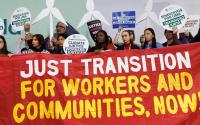Oct. 22 (Bloomberg) By Alex MoralesThe carbon dioxide concentration in the atmosphere is rising faster than expected as oceans and the land absorb a lower proportion of the gas and humans become less efficient at producing energy, an Australian-led team of scientists said.
Rising levels of the main gas blamed for climate change threatens to accelerate global warming, the researchers said. The study builds on previous findings and may lead to a change in the way scientists forecast climate change.
The growth rate for carbon dioxide, or CO2, emissions has averaged 3.3 percent a year since 2000, compared with 1.1 percent in the 1990s, according to today's study in the Proceedings of the National Academy of Sciences. The rate rose 35 percent more than economic growth had led scientists to anticipate, said Corinne Le Quere, one of the authors of the paper.
``The causes of the acceleration are surprising,'' Le Quere, a scientist at the U.K. government-funded British Antarctic Survey in Cambridge, said in a telephone interview. ``One is that we are not as efficient at using CO2 as we had anticipated, and the second cause is that it appears that the CO2 sinks are weakening,'' she said, referring to the oceans and land that absorb the gas.
The findings have implications for future predictions of global warming, because most climate models assume humans will improve the efficiency with which they produce energy, Le Quere said. Only the most extreme models predict a weakening of the carbon sinks in the present, she said.
Sooner Than Expected
``All of these changes characterize a carbon cycle that is generating stronger-than-expected and sooner-than-expected climate forcing,'' said the study's researchers, led by Joseph Canadell of the Commonwealth Scientific and Industrial Research Organisation, Australia's national science agency.
About 17 percent of the rise in growth rate can be attributed to an increase in the so-called carbon intensity of the global economy, a measure of the amount of carbon dioxide emitted per dollar of income generated, the scientists said.
``For 30 years we were becoming more efficient at using CO2 for producing energy and wealth, and this has completely stalled since 2000,'' Le Quere said, pointing in particular to the increasing use of coal as a source of fuel by developing countries such as China and India.
``Coal is more accessible and easier to use, and it's dirty,'' Le Quere said. ``It's 80 percent more CO2 intensive than gas, and 30 percent more than oil. Also, in the rich countries, there hasn't really been massive investment in technology, so we are indeed getting a bit more efficient with time, but not enough to compensate for the developing countries.''
`Big Concern'
The remaining 18 percent of the unexpected part of the gain in the emissions growth rate can be attributed to a decline in the effectiveness of seas and the land to absorb CO2, the scientists said. As a result, the fraction of emissions remaining in the atmosphere -- where it traps the sun's heat and causes warming -- has increased to 45 percent for the 2000 to 2006 period from 39 percent in the 1990s, they said.
``The implication is that more of the CO2 emitted stays in the atmosphere, and that's what causes global warming, so it's an acceleration of the warming,'' said Le Quere, who also works at England's University of East Anglia. The effect of the weakening sinks alone could add 1.5 degrees Celsius (2.7 degrees Fahrenheit) to the global average temperature by 2100, she said, adding that more work needs to be undertaken to identify the regions in which the oceans and land are losing their effectiveness as sinks.
``It's a big concern, particularly that we cannot really pinpoint where the sinks are weakening, except for in the Southern Ocean,'' Le Quere said. ``We cannot project things into the future if we can't identify them in the present.''






